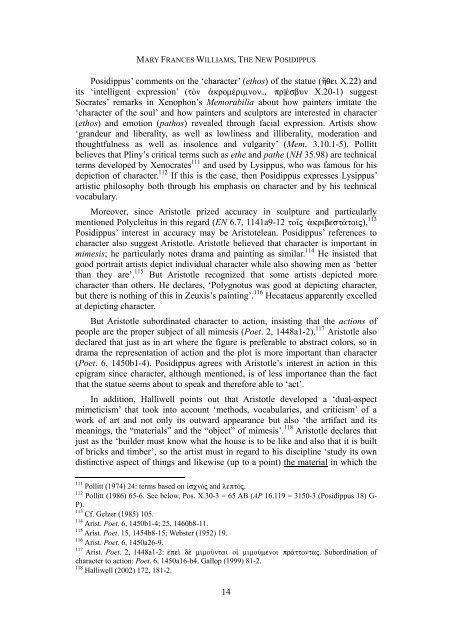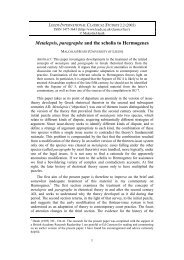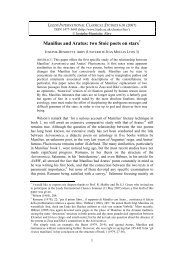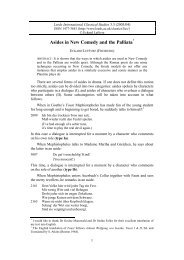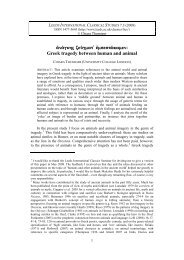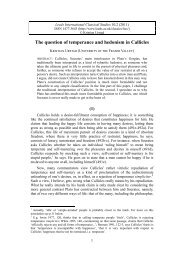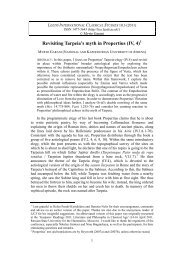The New Posidippus - Leeds International Classical Studies
The New Posidippus - Leeds International Classical Studies
The New Posidippus - Leeds International Classical Studies
You also want an ePaper? Increase the reach of your titles
YUMPU automatically turns print PDFs into web optimized ePapers that Google loves.
MARY FRANCES WILLIAMS, THE NEW POSIDIPPUS<br />
<strong>Posidippus</strong>’ comments on the ‘character’ (ethos) of the statue (½qei X.22) and<br />
its ‘intelligent expression’ (tÕn ¢kromšrimnon... pr]šsbun X.20-1) suggest<br />
Socrates’ remarks in Xenophon’s Memorabilia about how painters imitate the<br />
‘character of the soul’ and how painters and sculptors are interested in character<br />
(ethos) and emotion (pathos) revealed through facial expression. Artists show<br />
‘grandeur and liberality, as well as lowliness and illiberality, moderation and<br />
thoughtfulness as well as insolence and vulgarity’ (Mem. 3.10.1-5). Pollitt<br />
believes that Pliny’s critical terms such as ethe and pathe (NH 35.98) are technical<br />
terms developed by Xenocrates 111 and used by Lysippus, who was famous for his<br />
depiction of character. 112 If this is the case, then <strong>Posidippus</strong> expresses Lysippus’<br />
artistic philosophy both through his emphasis on character and by his technical<br />
vocabulary.<br />
Moreover, since Aristotle prized accuracy in sculpture and particularly<br />
mentioned Polycleitus in this regard (EN 6.7, 1141a9-12 to‹j ¢kribest£toij), 113<br />
<strong>Posidippus</strong>’ interest in accuracy may be Aristotelean. <strong>Posidippus</strong>’ references to<br />
character also suggest Aristotle. Aristotle believed that character is important in<br />
mimesis; he particularly notes drama and painting as similar. 114 He insisted that<br />
good portrait artists depict individual character while also showing men as ‘better<br />
than they are’. 115 But Aristotle recognized that some artists depicted more<br />
character than others. He declares, ‘Polygnotus was good at depicting character,<br />
but there is nothing of this in Zeuxis’s painting’. 116 Hecataeus apparently excelled<br />
at depicting character.<br />
But Aristotle subordinated character to action, insisting that the actions of<br />
people are the proper subject of all mimesis (Poet. 2, 1448a1-2). 117 Aristotle also<br />
declared that just as in art where the figure is preferable to abstract colors, so in<br />
drama the representation of action and the plot is more important than character<br />
(Poet. 6, 1450b1-4). <strong>Posidippus</strong> agrees with Aristotle’s interest in action in this<br />
epigram since character, although mentioned, is of less importance than the fact<br />
that the statue seems about to speak and therefore able to ‘act’.<br />
In addition, Halliwell points out that Aristotle developed a ‘dual-aspect<br />
mimeticism’ that took into account ‘methods, vocabularies, and criticism’ of a<br />
work of art and not only its outward appearance but also ‘the artifact and its<br />
meanings, the “materials” and the “object” of mimesis’. 118 Aristotle declares that<br />
just as the ‘builder must know what the house is to be like and also that it is built<br />
of bricks and timber’, so the artist must in regard to his discipline ‘study its own<br />
distinctive aspect of things and likewise (up to a point) the material in which the<br />
111<br />
Pollitt (1974) 24: terms based on „scnÒj and leptÒj.<br />
112<br />
Pollitt (1986) 65-6. See below, Pos. X.30-3 = 65 AB (AP 16.119 = 3150-3 (<strong>Posidippus</strong> 18) G-<br />
P).<br />
113<br />
Cf. Gelzer (1985) 105.<br />
114<br />
Arist. Poet. 6, 1450b1-4; 25, 1460b8-11.<br />
115<br />
Arist. Poet. 15, 1454b8-15; Webster (1952) 19.<br />
116<br />
Arist. Poet. 6, 1450a26-9.<br />
117<br />
Arist. Poet. 2, 1448a1-2: peˆ d mimoàntai oƒ mimoÚmenoi pr£ttontaj. Subordination of<br />
character to action: Poet. 6, 1450a16-b4. Gallop (1999) 81-2.<br />
118<br />
Halliwell (2002) 172, 181-2.<br />
14


